Ch 2: Enzymes (14%)
1/77
There's no tags or description
Looks like no tags are added yet.
Name | Mastery | Learn | Test | Matching | Spaced |
|---|
No study sessions yet.
78 Terms
Oxidoreductases
Name the Enzyme Class
catalyze oxidation-reduction reactions; often have a cofactor that acts as an electron carrier, such as NAD+ or NADP+; include dehydrogenases, reductases, and oxidases
Transferases
Name the Enzyme Class
catalyze the movement of a functional group from one molecule to another; includes kinases, which catalyze the transfer of a phosphate group, generally from ATP, to another molecule
Hydrolases
Name the Enzyme Class
catalyze the breaking of a compound into two molecules using the addition of water; includes phosphatase, peptidases, nucleases, and lipases
Lyases
Name the Enzyme Class
catalyze the cleavage of a single molecule into two products; do not require water; can also catalyze the synthesis of two molecules into a single molecule, but they are referred to as synthases in this case
Isomerases
Name the Enzyme Class
catalyze the rearrangement of bonds within a molecule; catalyze reactions between stereoisomers and constitutional isomers
Ligases
Name the Enzyme Class
catalyze addition or synthesis reactions generally between large similar molecules; often require ATP; most likely to be encountered in nucleic acid synthesis and repair on Test Day
overall free energy change, equilibrium
What 2 things in a reaction do enzymes NOT change?
lower the activation energy to increase the rate (make it easier for the substrate to reach the transition state)
What do enzymes do in reactions?
B complex vitamins, vitamin C (ascorbic acid)
name the 2 types of water-soluble vitamins that can act as cofactors
vitamin A, vitamin D, vitamin E, vitamin K
name the 4 types of fat-soluble vitamins that can act as cofactors
temperature, pH, salinity
name the 3 environmental factors that influence enzyme activity
Feedback Inhibition (aka Negative Feedback Regulation)
when the concentration of a product later in the metabolic pathway inhibits an enzyme earlier in the pathway
increase temperature, decrease activation energy
What are the 2 ways to increase the rate of a reaction?
activation energy
the minimum amount of energy it takes to pass over the transition state, meaning the reaction can proceed
increase, lowering
Enzymes ___________ reaction rates by ___________ transition state energies
both directions
A catalyst lowers the activation energy in _____ __________
Vmax
the maximum enzyme velocity once saturation has been reached (aka all the active sites are filled with substrate); appears as a horizontal asymptote on a Michaelis-Menten plot
total amount of enzyme
What does Vmax depend on?
Km
a measure of the affinity of an enzyme for its substrate; the amount of substrate that gives us half of Vmax
lower, it requires a higher substrate concentration to be half-saturated
Do enzymes with high Km’s have a HIGHER or LOWER affinity for its substrate?
Why?
higher, it requires a lower substrate concentration to be half-saturated
Do enzymes with low Km’s have a HIGHER or LOWER affinity for its substrate?
Why?
greater
Will changes in substrate concentration have a GREATER or LESSER effect on reaction rate when the substrate concentration is less than Km ([S] < Km)?
lesser
Will changes in substrate concentration have a GREATER or LESSER effect on reaction rate when the substrate concentration is more than Km ([S] > Km)?

pic
What is the general enzyme-substrate complex formular? (answer in pic)

(rate of substrate/enzyme complex dissociation + rate of product formation) / rate of enzyme/substrate complex formation
write out the formula for Km using the rate constants
high, saturated, [S]»Km
Does Vmax occur at low or high substrate concentration?
In this state, is the enzyme saturated or unsaturated?
In this state, what is the relationship between [S] and Km?
![<p>(Vmax x [S]) / (Km + [S]) </p>](https://knowt-user-attachments.s3.amazonaws.com/69b5bb21-1a60-4020-9dfd-83fde41fca69.png)
(Vmax x [S]) / (Km + [S])
write out the Michaelis-Menten equation
properties, enzyme
The unknowns Vmax and Km are ____________ of the particular __________
Km = [S]
write out the relationship between Km and [S] when the reaction velocity = ½ Vmax
higher, lower
More efficient enzymes have ________ Vmax’s and _______ Km’s which gives you a higher reaction velocity for a given level of substrate
Michaelis-Menten
Michaelis-Menten vs. Lineweaver-Burk Plot
displays a hyperbolic curve
Lineweaver-Burk
Michaelis-Menten vs. Lineweaver-Burk Plot
displays a linear function
Km/Vmax
write out the formula for calculating the slope of a Lineweaver-Burk plot
1/Vmax
write out the formula for calculating the y-intercept of a Lineweaver-Burk plot
-1/Km
write out the formula for calculating the x-intercept of a Lineweaver-Burk plot
cooperativity
enzymes that display this characteristic (ex: hemoglobin) have a sigmoidal (S-shaped) Michaelis-Menten graph
cooperativity
the phenomenon where the binding of a substrate molecule to one subunit of a multi-subunit enzyme influences the enzyme's affinity for additional substrates
> 1
Hill’s coefficient when positively cooperative binding is occurring, such that after one ligand is bound the affinity of the enzyme for further ligands increases
< 1
Hill’s coefficient when negatively cooperative binding is occurring, such that after one ligand is bound the affinity of the enzyme for further ligands decreases
= 1
Hill’s coefficient when the enzyme does not exhibit cooperative binding
Michaelis-Menten graph
Michaelis-Menten vs. Lineweaver-Burk Plot
What is this a picture of?
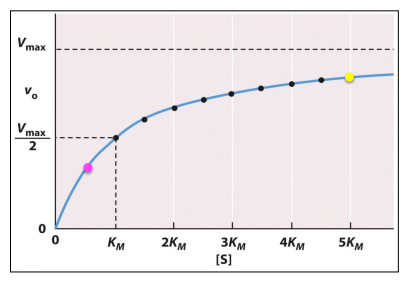
Lineweaver-Burk plot
Michaelis-Menten vs. Lineweaver-Burk Plot
What is this a picture of?
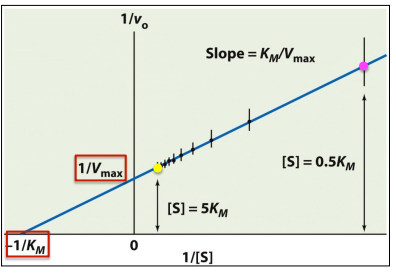
inhibitor
molecules that reduce the activity of an enzyme by combining it with a way that either affects substrate binding or affects conversion of substrate to product (can be a small molecule or a protein)
competitive inhibition
Name the Type of Reversible Inhibition
when inhibitor and substrate compete for the same active site; can be overcome by adding more substrate
no
Does competitive inhibition affect Vmax?
If so, does it increase or decrease it?
no, yes
Does competitive inhibition change the y-intercept?
Does competitive inhibition change the x-intercept?
low
Competitive inhibition has more of an effect at _____ levels of substrate concentration
yes, increase, decrease
Does competitive inhibition affect Km?
If so, does it increase or decrease it?
Does this mean an increase or decrease in binding affinity for the substrate?
competitive
Name the Type of Reversible Inhibition
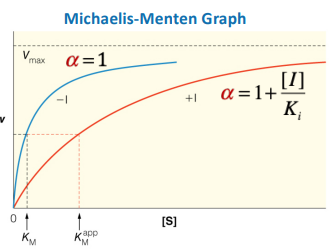
competitive
Name the Type of Reversible Inhibition

uncompetitive
Name the Type of Reversible Inhibition
When inhibitor binds to the enzyme-substrate complex (not the free enzyme) and prevents the conversion of substrate to product; can be interpreted as an increase in binding affinity between the enzyme and substrate
yes, decrease
Does uncompetitive inhibition affect Vmax?
If so, does it increase or decrease it?
yes, decrease, increase
Does uncompetitive inhibition affect Km?
If so, does it increase or decrease it?
Does this mean an increase or decrease in binding affinity for the substrate?
high
Uncompetitive inhibition has more of an effect at _____ substrate concentration
yes, yes
Does uncompetitive inhibition change the y-intercept?
Does uncompetitive inhibition change the x-intercept?
uncompetitive
Name the Type of Reversible Inhibition
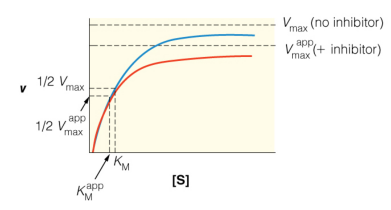
uncompetitive
Name the Type of Reversible Inhibition
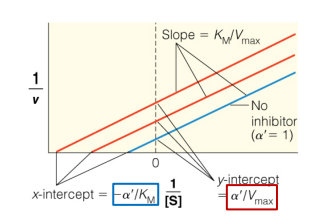
mixed
Name the Type of Reversible Inhibition
when the inhibitor binds to both the enzyme/substrate complex and the free enzyme, but has different affinities for each
competitive
Name the Type of Reversible Inhibition
prevents substrate binding to the enzyme
uncompetitive
Name the Type of Reversible Inhibition
prevents conversion of substrate to product
mixed
Name the Type of Reversible Inhibition
prevents both substrate binding & conversion of substrate to product
yes, decrease
Does uncompetitive inhibition affect Vmax?
If so, does it increase or decrease it?
yes (the change depends on whether or not affinity for the substrate is increased or decreased)
Does mixed inhibition affect Km?
yes, yes
Does mixed inhibition change the y-intercept?
Does mixed inhibition change the x-intercept?
mixed
Name the Type of Reversible Inhibition
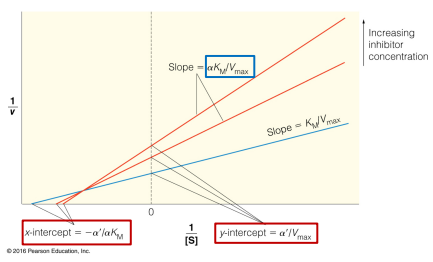
noncompetitive
Name the Type of Reversible Inhibition
when the inhibitors bind to an allosteric site instead of the active site, which leads to a change in enzyme conformation
yes, decrease
Does noncompetitive inhibition affect Vmax?
If so, does it increase or decrease it?
no
Does noncompetitive inhibition affect Km?
If so, does it increase or decrease it?
Does this mean an increase or decrease in binding affinity for the substrate?
yes, no
Does noncompetitive inhibition change the y-intercept?
Does noncompetitive inhibition change the x-intercept?
noncompetitive
Name the Type of Reversible Inhibition
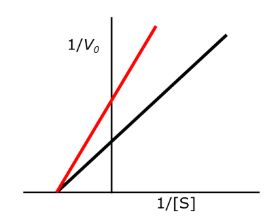
Select all of the following that would INCREASE the rate of a reaction:
A. decreasing the free energy (G) of the substrate
B. decreasing the free energy (G) of the product
C. increasing the temperature
D. decreasing the temperature
E. increasing the free energy of activation (delta G naught cross)
F. decreasing the free energy of activation (delta G naught cross)
C, F
A reaction proceeds at a rate ≈ Vmax. What is the substrate concentration [S]?
A. [S] = [E]T
B. [S] = Km
C. [S] = 2 x Km
D. [S] » Km
D
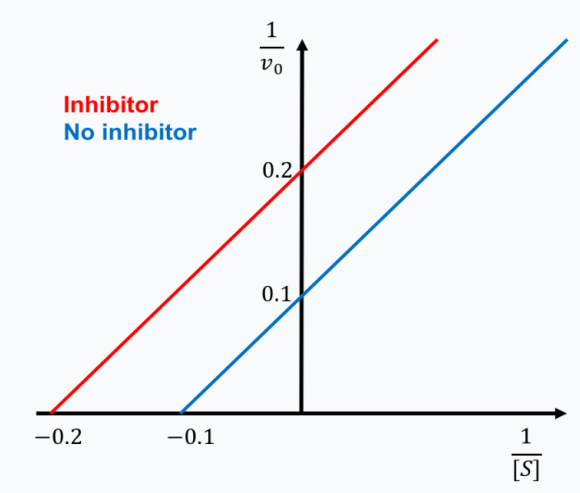
For the type of inhibition shown, what does the inhibitor bind to?
A. the enzyme only (E)
B. the enzyme:substrate complex only (ES)
C. Both the enzyme (E) and the enzyme:substrate complex (ES)
D. none of the choices are correct
B
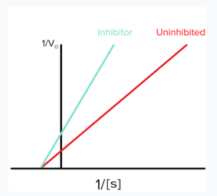
The graph shows a special type of mixed inhibition where the inhibitor binds both E and ES with equal affinity. How does the presence of this inhibitor change the EFFECTIVENESS of both Vmax and Km?
A. decreases Km; decreases Vmax
B. no change to Km; decreases Vmax
C. increases Km; decreases Vmax
D. no change to Km; increases Vmax
E. increases Km; no change to Vmax
B
Catalysts primarily work by:
A. providing additional kinetic energy for a substrate to overcome free energy barriers
B. increasing the free energy of the substrate
C. stabilizing the transition state of a reaction
D. decreasing the free energy of the product
C
In the case of competitive inhibition, which of the following statements about the Lineweaver-Burk plot is TRUE?
A. The slope does not change as inhibitor is added
B. The intersection point as inhibitor is added is given by [-1/α, 1/α]
C. The y intercept does not change as inhibitor is added
D. The x intercept does not change as inhibitor is added
C
In the case of uncompetitive inhibition, which of the following statements about the Lineweaver-Burk plot is TRUE?
A. The slope does not change as inhibitor is added
B. The x intercept does not change as inhibitor is added
C. The y intercept does not change as inhibitor is added
D. The intersection point as inhibitor is added is given by [-1/α', 1/α']
A
If a Lineweaver-Burk plot of a reaction is not linear, which of the following is TRUE?
A. The reaction is performed with a competitive inhibitor
B. The reaction is performed with an uncompetitive inhibitor
C. The reaction is performed with a mixed inhibitor
D. The reaction does not obey Michaelis-Menten kinetics
D